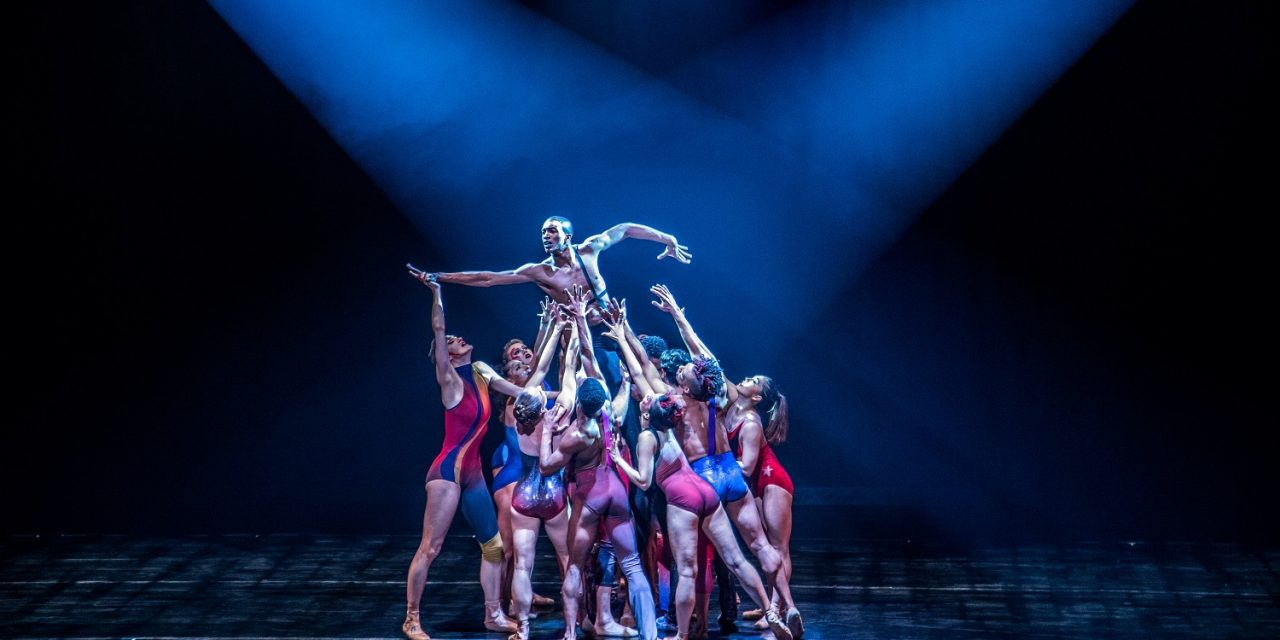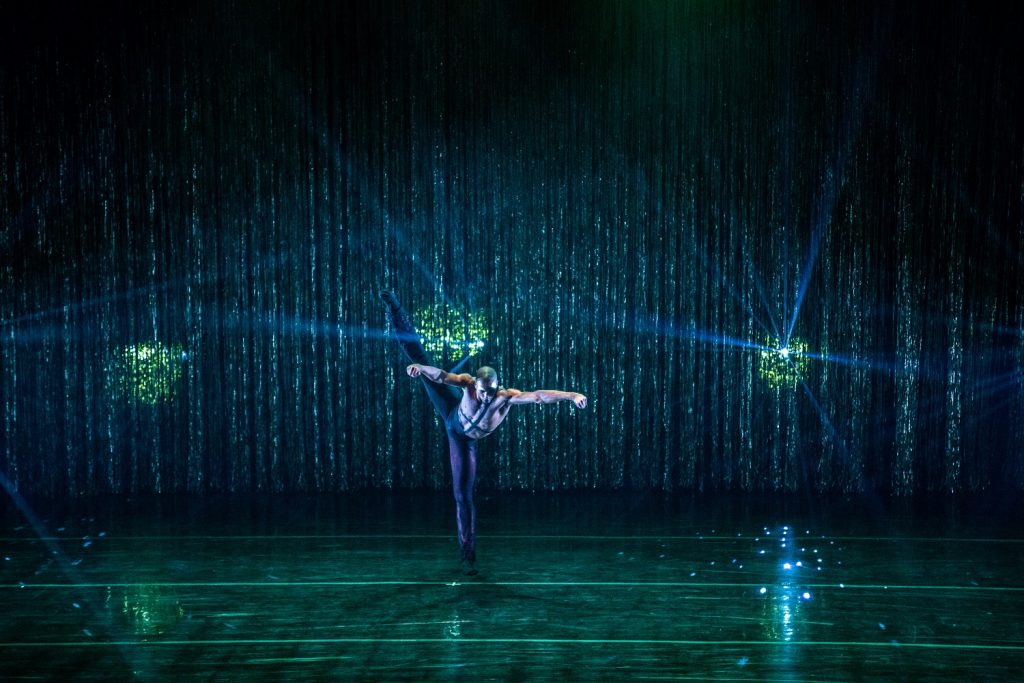Now in its 15th year, Glorya Kaufman Presents Dance at The Music Center is one of the leading presenters of dance on the West Coast, offering works by prestigious ballet and contemporary dance artists from around the world. Featured this past weekend in the Dorothy Chandler Pavilion was Complexions Contemporary Ballet, with choreographer Dwight Rhoden’s 2016 work StarDust, a “movement celebration of the life and music of David Bowie.”, and Bach 25 which premiered April, 2018 in Arcata, CA.
Founded in 1994, Complexions has received numerous awards including The New York Times Critics’ Choice Award. It has appeared throughout the US, at The Bolshoi Theater, The Kremlin, The Mikhailovsky Theater, and Melbourne Arts Center. Dwight Rhoden is the Founding Artistic Director/resident choreographer of Complexions Contemporary Ballet and was named by The New York Times as “one of the most sought out choreographers of the day.” Since 1994, Rhoden’s choreography has been the cornerstone of Complexions’ repertory. The other Founding Artistic Director, Desmond Richardson, was the first Black American Principal dancer of American Ballet Theater. He was in the original cast of Fosse on Broadway, the Principal character Tony in the Twyla Tharp Broadway production Movin Out and he performed in the Tony award winning Broadway production AfterMidnight. Richardson has also worked in Television and film
Bach 25 was set to the music of Johann Sebastian Bach and transcriptions, improvisations and interpretations on Classic Bach. What struck me about three quarters of the way through was how ceaseless it was. I longed for stillness or a slow movement phrase working against Bach’s intricate music. As beautiful as it was, the work was 25 minutes of constant movement, intricate and complex partnering, and innumerable entrances and exits from every possible direction.
Rhoden set up the movement themes in the opening solo performed magnificently by Desmond Richardson. Fast and percussive movement stopped abruptly on an accented cord in the music. Subtle gestures to the face, large extensions and long lunges that evolve into attitude turns or pirouettes. Richardson is a beautiful dancer and consummate performer. Sadly, we saw no more of him until the curtain call.
There is also another theme that ran throughout Bach 25 and, though altered, StarDust. That theme was how Rhoden backed up his duets with other dancers and/or introduced the next section. One duet had a line of dancers simply walking on the beat across the back of the stage. Another was more complex with the row of dancers performing a repetitive movement phrase in unison. A dancer or dancers ran onstage and began dancing as a duet came to its conclusion. All this added to how the motion never ended or rested.
The work was primarily movement based, but it hinted at a variety of emotions and relationships. Rhoden colored the music with his movement, and mostly it worked wonderfully. It was, as a colleague noted, quintessential Rhoden. For me, it was visually exhausting. One duet moved into four duets, then down to three and into a series of couples moving in canon across the space. There are several duets between Simon Plant and Timothy Stickney that are dynamic, athletic and performed with amazing agility and ease by the two men. Jillian Davis, who looked to be the tallest person in the company, drew my eye throughout. Not, however, because of her height, but because of how she used it in conjunction with her performance abilities. She moved as quickly as the shorter women or as slowly. Davis is stunning.
The cast included the company featuring Desmond Richardson. They were amazing and wonderful to watch. I applaud their technical skills, their ability to execute Rhoden’s fast paced movement with such consistency and their physical endurance. The gorgeous and simple beige costumes that allowed one to see the movement and which enhanced the dancers’ bodies were designed by Christine Darch, and the lighting that kept up with Rhoden’s speed was designed by Michael Korsch.
David Robert Jones was born in Brixton on January 8, 1947 and changed his name to David Bowie in 1966. Three years later,1969, Bowie’s legendary Space Oddity would peak at #5 in the United Kingdom. He became an international superstar in 1972 with his Ziggy Stardust persona. Bowie’s next phase of all-original work was unleashed in the form of the dystopian epic Diamond Dogs. In the mid-1970s Bowie moved to Los Angeles and starred in the cult classic Nic Roeg science fiction film The Man Who Fell To Earth. He appeared in many films including the 1983 film The Hunger along with Catherine Deneuve and Susan Sarandon. Bowie continued to produce music albums and appear in film throughout the 1980s and 1990s. After a long and legendary career in music and film, David Bowie died of cancer on January 10, 2016, two days after his 69th birthday and the release of his final album Blackstar.
StarDust was a brilliant and sometimes sparkling tribute to Bowie’s music and to his many talents as a performer. Michael Korsch’s lighting, Christine Darch’s costumes and the makeup all came together with Rhoden’s choreography to create a work that was not only entertaining, but an outstanding production. According to the program, “StarDust is the first installment of a full evening length ballet tribute to the genre bending innovation of one of the most prolific rock stars of our time – David Bowie.”
The action started from the time the curtain went up, assaulting our senses with rock concert-like lighting that pierced through a tinseled curtain, causing rotating beams of light to radiate beyond the stage proscenium and into the house.
Throughout, the movement was busy, but Rhoden directed one’s eye by featuring a central figure who lip synced Bowie songs, pulling them outside the action. Each of the nine songs had a different dancer acting as Bowie, including a few women. In a couple places, a song had a male and a female as Bowie. This, plus Addison Ector dancing en pointe and seductively walking around en pointe during Space Oddity, brought focus to Bowie’s now infamous gender bending performances. Rhoden also shifted how featured dancers entered and exited by evoking techniques utilized by magicians.

Timothy Stickney, Young-Sil Kim – StarDust – Complexions Contemporary Ballet – Photo Courtesy of Hagos Rush
Simon Plant was one of the few who managed to lip sync and dance throughout his song. Most stopped periodically to dance. Jillian Davis and Andrew Brader were wonderful together. The chemistry between them was sometimes lacking in other duets. Brandon Gray stood out in the opening section to the song Lazarus, one of Bowie’s last, as did Andrew Brader in Changes.
StarDust attacks one’s senses from all directions in the most delightful ways. It is brilliantly made, magnificently performed and highly entertaining. It is the best of Dwight Rhoden and his company of dancers are some of the best. They were: Greg Blackmon, Andrew Brader, Erin Brothers, Daniel Cooke, Jillian Davis, Addison Ector, Larissa Gerszke, Brandon Gray, Shanna Irwin, Young-Sil Kim, Kelly Marsh IV, Simon Plant, Kelly Sneddon, Timothy Stickney, and Candy Tong.
For more information on Complexions Contemporary Ballet, click here.
Feature Photo: Complexions Contemporary Ballet in StarDust, Photo courtesy of Hagos Rush.










